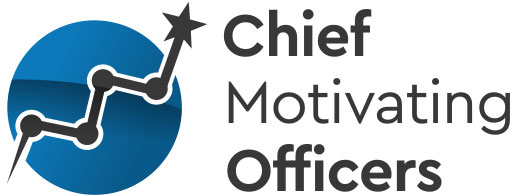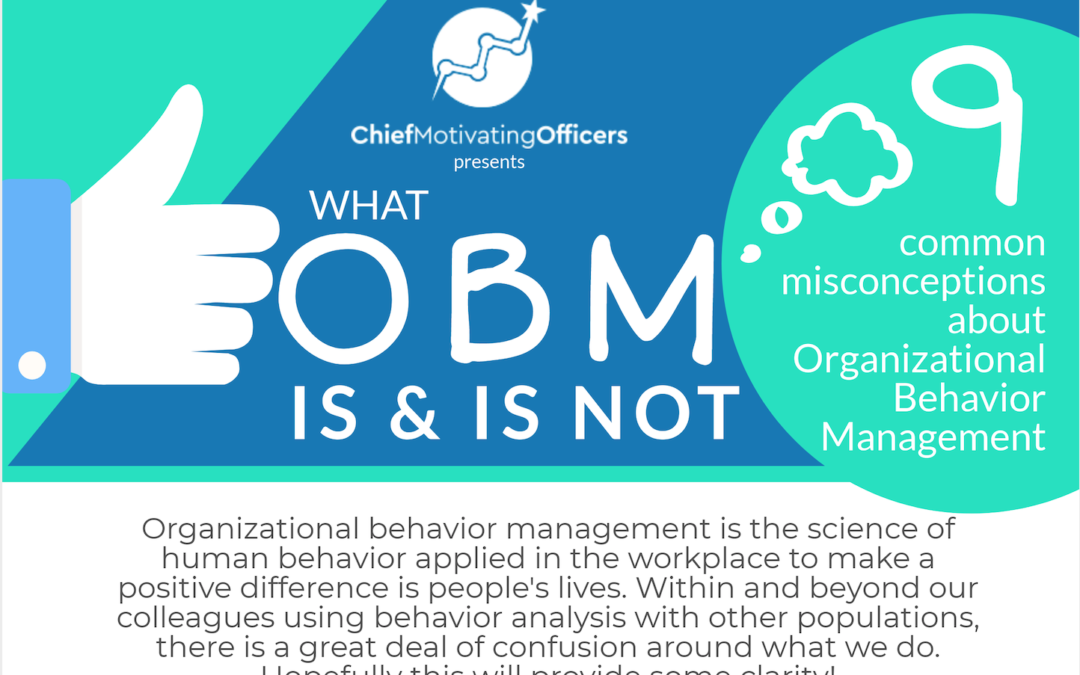This infographic explores nine common misconceptions that I’ve come across often in my career as an Organizational Behavior Management (OBM) practitioner. I’ve been shocked about how much, even within the field of Applied Behavior Analysis, OBM is so often misunderstood. Hopefully this can help people have a better grasp of what OBM is, and is not!

Chief Motivating Officers presents…
What OBM Is and Is Not: 9 Common Misconceptions About Organizational Behavior Management
Organizational behavior management is the science of human behavior applied in the workplace to make a positive difference is people’s lives. Within and beyond our colleagues using behavior analysis with other populations, there is a great deal of confusion around what we do. Hopefully this will provide some clarity!
OBM is… Hard science: OBM focuses on only what is observable and measurable, and uses the scientific method and hard data to ensure our practices are empirically validated and scientifically sound.
OBM is NOT… Soft science: OBM does not typically focus on internal states, personality traits, or anything that can’t be observed by multiple individuals. OBM is not only based upon correlation like many softer sciences, such as psychology.
OBM is… Behavior analysis: OBM is the application of BF Skinner’s radical behaviorism and the science of human behavior in organizational contexts. OBM spans across many industries and many applications, but always focuses on its root scientific foundation.
OBM is NOT… I/O – OD – OB: While we work alongside practitioners in these other areas, we are not them. These programs are often housed in business schools, use group-design methodology, don’t have the same theoretical and philosophical foundation, and focus on different objects of study, like personality and hiring practices.
OBM is… Individualized: Although often used to impact group behavior, OBM practitioners will also ensure that the performance of each individual is increasing. Performance varies for different reasons for everyone.
OBM is NOT… Group-focused: Using the mean of a group does not guarantee individual performance has been increased, and you can lose important individual differences by focusing on data in large groups.
OBM is… Very diverse: Specialty areas within OBM include, and are not limited to: performance management, behavior-based safety, behavioral systems analysis, change management, and consumer behavior analysis.
OBM is NOT… Performance management: PM is a big area for OBM practitioners to work within, but there is more to the science than just improving individual performance alone, and those other areas are definitely worth studying.
OBM is… Diagnostic: Performance diagnostics, preference assessments, and functional behavior assessments are important tools for OBM practitioners to ensure we are using the right interventions to improve performance.
OBM is NOT… One-size-fits-all: Often, individuals will default to training as the solution for performance problems at work; however, without a proper analysis, we may be implementing expensive trainings for nothing.
OBM is… Data-based: OBM practitioners use data to guide every aspect of their work: which interventions to implement, whether they’re effective or should change, and whether they sustain over time.
OBM is NOT… “Set and Forget”: OBM practitioners do not put an intervention in place and leave. Without appropriate data collection and follow-up, initiatives often become “flavor of the month” and will not maintain.
OBM is… Sustainable: When implementing change, the OBM practitioner builds interventions for lasting change. This includes transitioning the tasks to internal team members, training leaders to reinforce behavior around the change, and developing systems and processes to ensure the changes maintain after they leave.
OBM is NOT… Quick fix: In order to be sustainable, the changes that OBM practitioners implement take work, buy-in, time, and patience. OBM interventions are often not “quick fixes”, which are implemented without proper analysis, diagnostics, and research to make sure the right interventions are in place and the right people are involved.
OBM is… Socially valid: Social significance is a huge aspect of behavior analysis, and in OBM it’s no different. The interventions we implement should be to encourage change that is important to the organization, to the stakeholders, and most importantly, to the employees. OBM practitioners want to ensure that what we do is reinforcing to all involved.
OBM is NOT… Arbitrary: OBM practitioners do not just implement whatever changes the highest bidder is looking to enact. We have an ethical obligation to not focus only on increasing the performance of employees that lead to the highest bottom line, especially not at the expense of employee satisfaction and safety, as well as on society, the environment, and the world.
OBM is… Complex: OBM practitioners often have years of formal training and/or experience. There are entire degree programs devoted to learning how to apply this science.
OBM is NOT… Simple: One course or reading or experience in OBM is likely not enough for one to be an effective practitioner, and mentorship is HIGHLY advised for newcomers.
We hope this can provide some clarity, and feel free to contact us with any questions!


A concern with the “OBM” label is that it is not recognized as a discipline, specialty, department, or even area of consultation outside of a very narrow community of behavior analysts. One generally does not get a job in a department or with a title that includes OBM, so almost by definition one must became a Human Resources, Process Improvement, Org Development, Training, Performance Consulting, or other professional by title to apply OBM in the marketplace. From a career path perspective, it would be very helpful, I believe, for OBM students — who tend to be somewhat naive about these issues until they hit the marketplace — to have background, at least introductory familiarity with one or more of the disciplines and organizations defined by these other labels, and to see how the skills and expertise they have developed in OBM can be described and applied in other fields.
This is helpful to the novice practitioner (supervisee). Thanks!